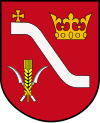 Alternate names: Proszowice [Pol], Proshovitza, פרושוביצה [Yid], Proshovitze, Прошовице [Rus]. 50°12' N, 20°18' E, 46 miles SSW of Kielce, 19 miles ENE of Kraków, 16 miles SE of Miechów. 1900 Jewish population: 639. Proszowice powiat is a unit of territorial administration and local government in Lesser Poland Voivodeship, southern Poland since January 1, 1999 with its administrative seat and only town is Proszowice, 31 km (19 mi) NE of the regional capital Kraków. Gmina Proszowice is part of Malopolskie powiat. The 2006 total population was 43,441, out of which the population of Proszowice was 6,205. photos. photos. [June 2009]
Alternate names: Proszowice [Pol], Proshovitza, פרושוביצה [Yid], Proshovitze, Прошовице [Rus]. 50°12' N, 20°18' E, 46 miles SSW of Kielce, 19 miles ENE of Kraków, 16 miles SE of Miechów. 1900 Jewish population: 639. Proszowice powiat is a unit of territorial administration and local government in Lesser Poland Voivodeship, southern Poland since January 1, 1999 with its administrative seat and only town is Proszowice, 31 km (19 mi) NE of the regional capital Kraków. Gmina Proszowice is part of Malopolskie powiat. The 2006 total population was 43,441, out of which the population of Proszowice was 6,205. photos. photos. [June 2009]
US Commission No AS 175
Proszowice is located in the Krakow region at 50º12N 20º17E, 22 km NE of Cracow. The Jewish cemetery is located on Krakowska Street, approximately 1.5 km from the city center, at Proszowice-Krakow road. Present town population is 5,000-25,000 with no Jews.
- Town: Urzad Miasta, tel. 861005, Urzad Miasta, Wydzial Geodezji, tel. 861005, ext. 44. Local: Urzad Wojewodzki, Krakow, 22 Basztowa Street, tel. 160200; fax 227208. Urzad Wojewodzki, Wydzial Spraw Spolecznych, Krakow, 22 Basztowa Street, tel. 226828, 223371, 160268--Inspektor d/s Stowarzyszen i Wyznan, pok. [Room] 273.
- The Kongregacja Wyznania Mojzeszowego [Jewish Congregation] at 2 Swaniska Street in Cracow, tel. 562349.
- Regional: Panstwowa Sluzba Ochrony Zabytkow, Wojewodzki Konserwator Zabytkow, Krakow, 3 Wszystkich Swietych Square, tel. 225977, fax 161417; osoba zajmujaca sie cmentarzami [person dealing with cemeteries], tel. 161415.
- Interested: (1) Regionalny Osrodek Studiow i Ochrony Krajobrazu, Krakow; and (2) Komitet Opieki nad Zabytkami Kultury Zydowskiej-sekcja Towarzystwa Milosnikow Historii i Zabtkow Krakowa, 12 Swietego Jana Street.
- Interested: (1) Sad Wojewodzki--Wydzial Ksiag Wieczystych [Woivodship Court of Justice--Dept. Of Land Record Book], Krakow, 7 Przy Rondzie Street, tel. 114100; Archiwum, pok. [Room] 119); (2) Wojewodzkie Archiwum Panstwowe, Krakow, 2 Sienna Street, tel. 224094; and (3) Wojewodzkie Archiwum Panstwowe, Kielce.
- Jewish cemetery key: Ms. Zlocka at Urzad Miasta Wydzial Geodezji, tel. 861005, ext. 44.
The earliest known Jewish community was about 1500. 1921 Jewish population was about 1,307 people. The landmarked Orthodox Jewish cemetery was established in the 18th century with last known Jewish burial probably 1941. The isolated suburban flat land has a sign/plaque in Polish mentioning the Jews. Reached by turning directly off a public road, access is open with permission with a continuous fence and locking gate. The size of the cemetery before W.W.II was approximately 0.36 hectares; it is 0.3385 hectares now. 1-20 gravestones, none in original location and less than 25% toppled or broken, date from the 18th- 20th centuries. The marble and sandstone finely smoothed and inscribed stones or flat stones with carved relief decorations have Hebrew inscriptions. Some tombstones have traces of painting on their surfaces. The cemetery contains no known mass graves. A private individual owns site used as a Jewish cemetery. Properties adjacent are agricultural. Compared to 1939, the cemetery boundaries enclose a smaller area due to agriculture and fence. A strip of land now divides it from the road (previously contained a pre-burial house, etc.). Private Jewish and non-Jewish visitors rarely visit. The cemetery was vandalized during W.W.II. In 1989, local/municipal authorities and Jewish individuals abroad re-erected tombstones and partially restored site with wall and gate fixed/constructed. Max Just, a Jewish survivor from Germany, pays regularly for occasional clearing or cleaning. There is a weather erosion threat; vegetation is a seasonal problem preventing access.
Malgorzta Radolowicz of 37 Florianska Street, apt 3, Krakow completed this survey on July 24, 1995 and visited site. The individuals interviewed for this survey were (1) Ms. Halina Zlocka, City Council, on 7/24/95; (2) miscellaneous local residents on 7/24/95; and (3) Tadeusz Jakubowicz on 8/18/95. A land survey chart at the Local Community Council was also consulted.
